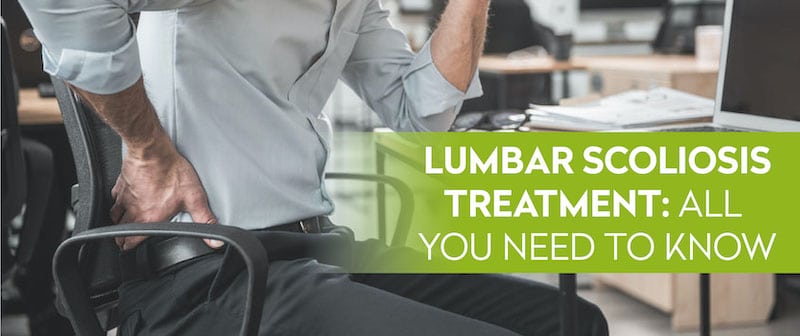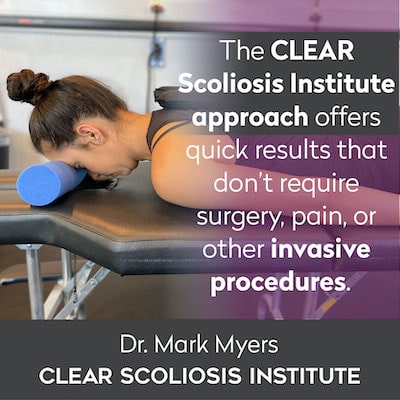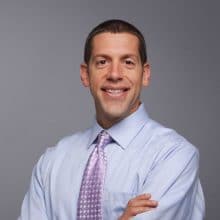
Pain in the lower back is common in adult patients with lumbar scoliosis and, less frequently, in some cases with teenagers. Fortunately, there are several treatments available.
Do you want to know the best forms of lumbar scoliosis treatment? The CLEAR Scoliosis Institute approach offers quick results that don’t require invasive procedures and has helped many patients avoid surgery. In fact, many patients often notice that pain is the first symptom to go away.
In addition, there are quite a few other common symptoms of lumbar scoliosis. For more information, read on.
Lower back pain is something that many adults have to deal with. Lower back pain can be caused by many different things - one of which is lumbar scoliosis. Getting an exam from a clinician specializing in scoliosis is the only way to know what the problem is; however, most scoliosis cases are idiopathic, meaning the cause is unknown. There are dozens of symptoms that go along with lumbar scoliosis.
Some of the most common physical signs include the following:
If you have lumbar scoliosis, you might also notice that there are a few cosmetic changes as well:
Self-diagnosing yourself or a family member with lumbar scoliosis is never a good idea. You may end up with incorrect results or other issues. Even if you’re correct with the diagnosis, treatment requires professional attention. If you notice any symptoms of lumbar scoliosis, or scoliosis in general, it’s time to seek the help of a chiropractor specializing in scoliosis.
When a patient comes in claiming that they have scoliosis, doctors still have to perform a series of tests to confirm the condition. In many adult cases, patients are experiencing pain, height changes, one shoulder higher than the other, and other signs that lead doctors to do further testing. If scoliosis is suspected, an X-ray will often be ordered and what’s called a Cobb angle measurement will be taken.
The Cobb angle is the most commonly-used assessment method to indicate whether or not a patient has a curve in their spine and the severity of it. A forward bend test, a visual assessment that screens for indicators of the condition, is typically performed as well. A curvature of 10 degrees or more is when scoliosis is diagnosed by most medical professionals.
The pelvis should be at the center of the spine, and another test is sometimes done to review if there’s a slight deviation to either side of the pelvic bone. Lumbar scoliosis is the closest connection to this region, which makes it easy for specialists to spot.
The further the spine shifts off of the pelvic bone, the harder it will be to correct the curvature completely. In some cases, it can be a challenge to reduce a curvature significantly; however, when combined with the CLEAR method, an effective and sustainable, scoliosis-specific exercise regime can be highly beneficial.
Depending on the age of the child and the amount of degeneration in the spine, it can be quick to correct with stretches, chiropractic adjustments, and other basic exercises. Thanks to modern advancements in the industry, patients are able to have their spinal curvature reduced. Children typically receive better results, but adults can benefit from this method as well.
The CLEAR method completely changed the way that we view scoliosis patients. It was put into practice in the year 2000, currently with 31 clinics offering the painless, drug-free solution to spinal curvatures and their symptoms.
Doctors recommend that patients with lumbar scoliosis stay hydrated for two reasons:
However, when the discs and surrounding joints begin to break down, correction becomes a bit more challenging. There are certainly limits if a patient has irreparable bone damage. Surgery is a possibility, but one of the primary goals of the CLEAR approach is to avoid invasive surgery.

Here are some of the most common activities:
Lumbar scoliosis is a very particular disorder that requires specific treatment. Self-diagnosis is never the right solution, but you should keep an eye out for the symptoms to see if you need to schedule a visit to the doctor’s office. Remember that some of those symptoms include:
Doctors can perform assessments and measurements to check if a patient has lumbar scoliosis. Common diagnostic methods include visual assessments such as the Adam’s forward bend test, a scoliometer to measure the rib arch on one side of the body, X-ray images, and taking the patient’s Cobb angle measurement.
Using spinal weights, wedges, rolls, adjustments, and other tools, chiropractors specializing in scoliosis are often able to improve lumbar scoliosis without requiring drugs, injections, or surgery. Remember that a curvature can often be reduced, but in severe cases in which discs are permanently damaged, the repairs are limited. Treatment always works better when it’s performed before the condition progresses.
Additional Resources:
Disclaimer: The author’s views are his or her own and may not reflect the views of CLEAR Scoliosis Institute. (to be placed at the bottom of blog post)

CLEAR provides a unique and innovative way of understanding scoliosis. Sign up to receive facts and information you won’t find anywhere else.
